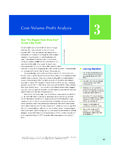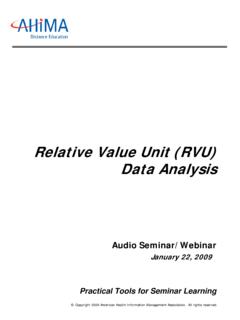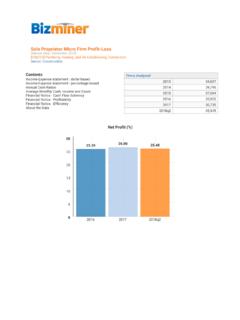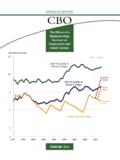Transcription of Breakeven Analysis - Management By The Numbers
1 Breakeven AnalysisThis module covers the concepts of variable, fixed, average and marginal costs, contribution, contribution margin, unit and dollar Breakeven : Paul FarrisMarketing Metrics Reference: Chapter 3 2011-2017 Paul Farris and Management by the Numbers , and Variable CostsMBTN | Management by the NumbersDefinitionVariable Costs (VC): Costs that change with volume sold. Examples include material used to construct a product, commissions paid to salespeople, and packaging costs. Variable costs are usually assumed to be relatively constant on a per-unit definition, those costs that are not fixed are variable!DefinitionFixed Costs (FC): Costs that remain unchanged with volume sold.
2 Examples include rent for facilities, Management salaries, and most advertising Variable Costs from Fixed CostsMBTN | Management by the NumbersNote visually how variable costs as well as total costs increase with units sold while fixed costs remain Costs = Total Fixed Costs + Total Variable CostsTotal costs ($)UnitsTotal Fixed Costs (don t change with units sold)Total Variable Costs (change at a constant rate)Total Costs =FC+VC0 FIXEDORVARIABLE?4 Fixed or Variable?MBTN | Management by the for office Force Force shipping s limo lease warranty expensesFixed1____2____3____4____5____6_ ___7____8____Variable1____2____3____4___ _5____6____7____8____MOREONVARIABLECOSTS 5 More on Variable CostsMBTN | Management by the NumbersUnits Sold1101001,000 VariableMfg.
3 Costs2202002,000 PackagingMaterial3303003,000 Unit Variable Cost5555 Total Variable Costs5505005,000 DefinitionsUnit Variable Cost = Total Variable Costs for 1 Unit of ProductionTotal Variable Costs = Unit Variable Costs * Units SoldIn this example, the unit variable cost equals the variable mfg cost ($2) plus the packaging material ($3). The unitvariable cost remain constant at $5 as volume increases, while totalvariable costs increase with volume , variable costs will decrease with volume. This might occur due to impacts such as volume discounts or economies of CostsMBTN | Management by the NumbersUnits Sold1101001,000 FixedCosts500500500500 VariableMfg.
4 Costs2202002,000 PackagingMaterial3303003,000 Total Variable Costs5505005,000 Total Costs5055501,0005,500 Average Costs = FC + VC = Fixed Costs + (Unit Var. Cost * Units Sold)Average Costs = Total Costs / Units SoldNow let s add fixed costs to our example. As the number of units sold increases, fixed costs stay fixed at $500, unit variable costs remain constant at $5, total variable costs increase with each additional unit sold, and the average cost per unit decreases as more units are VARIABLECOST7 Marginal vs. Variable CostMBTN | Management by the NumbersInsightA brief digression for those remembering Economics 101 Marginal Costs vs.
5 Variable Costs Almost the same concept: Marginal cost refers to what it costs to produce an additional unit; variable cost Analysis usually assumes constant marginal cost. Over a wide range of output, the unit variable costs may not change. Therefore the marginal cost of producing an additional unit and the variable cost for that range will be the same. Over some range, variable costs might change (discounts from suppliers for a larger order of packaging materials, for example) but still would not be considered fixed and ProfitsMBTN | Management by the NumbersUnits Sold @ $121101001,000 TotalRevenues121201,20012,000 Total Variable Costs5505005,000 Total Contribution7707007,000 FixedCosts500500500500 Profit (Loss)-493-4302006,500 DefinitionsTotal Revenues = Selling Price * Units SoldTotal Contribution = Total Revenues Total Variable CostsProfit (or Loss if negative)
6 = Total Revenues Total Costsor Profit = Total Contribution Fixed CostsUp to now, we ve been discussing costs. Let s add revenues to the equation. Total Revenuesequals the selling price x unit sales. Total Contribution is the difference between revenues and variable costs. The Profit(or loss if negative) is the difference between total revenues and total and ProfitsMBTN | Management by the Numbers The firm becomes profitable where total revenues crosses total costs Since fixed costs don t change over the short-term, they may be sunk costsAdding revenues and profits to our total cost / units graph, visually, might look something like this:Total costs ($)UnitsTotal Fixed CostsTotal Costs0 Total RevenuesProfit!
7 CONTRIBUTION10 ContributionMBTN | Management by the NumbersTotal variable costs and revenues ($)UnitsTotal Variable CostsTotal Contribution0 Total Revenues - Total Variable Costs = Total Contribution Total RevenuesTake a moment to consider why unit contribution might be .. minusDefinitionsUnit Contribution = Selling Price per unit Variable Cost per unitContribution Margin %= Unit Contribution / Selling Price per unitCONTRIBUTION: SAMPLEPROBLEMS11 Contribution: Sample ProblemsMBTN | Management by the NumbersUnit Contribution is significant because it measures a netinflow of funds to a company as additional units are 1:If a firm receives $12 revenue from each unit it sells, and pays $5 per unit in variable costs, then what is the contribution of each unit?
8 Answer: We know that Unit Contribution = SP per unit VC per unitTherefore, substituting in our values:Unit Contribution = $12 -$5 Unit Contribution = $7 Let s try a few contribution calculations:CONTRIBUTION: SAMPLEPROBLEMS12 Contribution: Sample ProblemsMBTN | Management by the NumbersQuestion 2:If a firm realizes $50 in total contribution by selling 10 units of a product at a selling price of $20, what is the unit variable cost per unit? Answer: We know that Total Contribution = Unit Contribution * Units SoldAnd that Unit Contrib. = Selling Price per unit - Variable Cost per unitTherefore, substituting in our values:$50 = Unit Contribution * 10 Unit Contribution = $50 / 10 Unit Contribution = $5$5 = $20 - Unit Variable CostUnit Variable Cost= $20 - $5 Unit Variable Cost= $15 CONTRIBUTION: SAMPLEPROBLEMS13 Contribution: Sample ProblemsMBTN | Management by the NumbersQuestion 3:If a firm receives $100 revenue from selling 5 units of a product, and pays $25 in total variable costs, then what is the contribution and contribution margin (%) of each unit?
9 Answer: We know that Total Revenues = Selling Price per unit * Units Sold$100 = SP * 5; Selling Price = $20and Total Variable Costs = Unit Variable Costs * Units Sold$25 = Unit Variable Costs * 5; Unit Variable Costs = $5and Unit Contribution = SP per unit VC per unitUnit Contribution = $20 -$5 = $15and Contribution Margin % = Contribution / Selling PriceContribution Margin % = $15 / $20 = 75%CONTRIBUTIONANALYSIS14 Contribution AnalysisMBTN | Management by the NumbersSome of the types of questions that contribution Analysis can help answer include:Will our unit prices cover unit variable costs?Target unit volumes: Will the additional contribution cover our fixed costs and make a profit ?
10 We want to sell 10,000 units. Will the contribution cover our fixed costs?How much can we afford to pay marketing to sell an additional unit? If an advertisement cost $1,000, how many units will we need to sell to make it worthwhile? What kinds of commission programs are feasible for our salespeople?BREAKEVEN15 BreakevenMBTN | Management by the NumbersTotal costs ($)UnitsTotal Fixed CostsTotal Variable CostsTotal Costs0 Breakeven is where total revenues = total costs Total RevenuesProfit! Breakeven Point:(Total Costs = Total Revenues)Break-even Volume in UnitsBreakeven Volume in DollarsBug fixBREAKEVEN16 BreakevenMBTN | Management by the Numbers Not a loss, but zero Selling enough to just cover fixed costs Where a business becomes profitable Each sale contributes to covering a portion of fixed costs The amount each sales contributes to covering fixed costs is the difference between unit price (revenue) and unit variable costs ( unit contribution) Marketers (and CFOs) like to know how high sales have to be to Breakeven ( where do we become profitable?)






